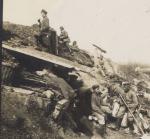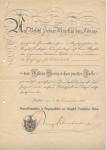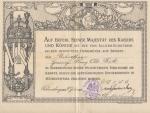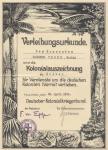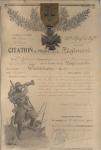-
Posts
29,251 -
Joined
-
Last visited
-
Days Won
84
Content Type
Profiles
Forums
Blogs
Gallery
Events
Store
Everything posted by Chris Boonzaier
-
As darkness fell we consolidated our position, the H.Q. advancing to the wells. On the way, next to a bush, we passed a badly wounded officer. He was breathing painfully, a comrade was holding his hand and comforting him. In front of the well a soldier crawled past, he was shot through the leg and dragged himself along on his arms and healthy leg. Laying against a tree was a dead soldier, his tunic unbottened, his chest covered in dry, black blood. Heat, dust, a smell of decay hanging in the air. The column formed a square facing outwards, an Igl (hedgehog). At this point we dlscovered that the 9. Komp. had not yet arrived at our level and that the medical section was still missing. We were discussing whether to break out and send a group to look for them when suddenly the ambulance came crashing through the bush. The wheels began to sink in the sand and for a moment we were worried that the big waggon would get stuck, finally it ground into the hedgehog. The doctors pulled on their aprons and set up their operating tables in front of their wagon. As bullets flew through the camp the doctors started to operate, stopping flowing blood, setting splintered bones and trying to still extereme pain. Automatically philosophical thoughts cropped up... Wasn?t war something terrible? Was it not crazy that on both sides, people who did not know each other shot at each other, trying to damage eachothers bodies, while here the doctors operated trying to fix those shattered bodies. On the battlefield the hours of tension and stress made the mind wonder, to a utopia where there wass no war and where mankind lived in peace. As night fell the shooting died down. We assumed the enemy would attack us during the night or the early hours of the morning. Thorn branches were chopped to build fences and barriers with holes for the fieldguns. From behind we heard cries of joy as the missing 9. Komp. with two machineguns pushed ist way into the Igl. At last the whole column was reunited. At about 7.30 pm the last shots sounded, then night fell on the bush. Inside the square lay 12 dead and 33 wounded . Of the 11. Komp. 18% of the men were out of action, the 10. Komp. had lost 11 of it?s men. The men of the 10. Komp. had been so calm and disciplined in the 10 hour battle that they had used on average only 45 bullets per man. The enemy had fired on us with all possible forms of projectile, using the oldest flintlocks, blunderbusses and modern rifles we had suffered bullets, leadshot, dumdums, even scrap iron. At 7.00pm we had recieved a message from v.d. Heyde. They had reached a vley about 15km?s to the northeast of Hamakari. From here their artillery had fired on the dustcloud which was retreating towards the Waterberg. They had to cease fire due to ammunition shortages. V.d. Heyde was intending to continue his progression to meet up with us. Neither v.d. Heyde or Deimling managed to reach us. Due to our exhausting fight and heavy losses we were not able to continue. All around us lay the enemy but due to the thich bush we had no way to estimate their numbers. We lay behind our barricades, watching, waiting ... freezing. The signallers worked without break as the messages flew backwards and forwards. Just before midnight a message arrived from v.d. Heyde. On his breakthrough attempt they had been attacked and had had to pull back. Ordered to advance again they signalled back that this was, under the circumstances, not possible. And so it seemed that the first day had been only partially succesful. We were of the opinion that the enemy was still present in force and that the next day would see even harder fighting. At 2.00am a message from Deimling announced that they had taken the station at Waterberg and would be arriving ar Hamakari in the morning. The situation had changed to our advantage! It was evident that the enemy resistance was breaking. Only our weaker Abteilung was no longer capable of pursuit. The next day the chase would begin. The night was suprisingly quiet, no shot was fired. Our eyes scanned the darkness looking (thats is how far I have got so far...)
-
I know that folks loose a thread when there are more than 5 lines of text in a block.... but bare with me, it is not ofen that you can pinpoint a man down to a group of 200 on a battle field... he was with the 5th batterie In front of us the bush was still silent. We passed through abandoned settelments, fresh footprints and scattered possesions indicated a rapid flight. We stopped for a moment to allow the Abteilung to regroup. On the ground in front of us lay native jewellary made out of lead rings and a childs shoe. The commander in chief picked it up to examine it. Not only the warriors were on the move, but the whole Volk was fleeing from us. We heard the cattle herds in the distance and saw rising clouds of dust, where they were headed we could not know. We continue forward, the skirmish lines pushing forward along the snaking riverbed. I am keeping the heaquarters war diary and have just picked up my pencil and checked my watch (it was 8.45 a.m.) when the first shot rings out. A volley of shots follow. They come hissing, whizzing over our heads. Instinctively we duck. One laughs when one reads of men ducking their heads, once one hears the shot it is too late to duck, but we do it all the same. The intensity of the fire increases. Machineguns are rushed forward, the skirmish lines have already suffered heavy losses, the Witboois and 11. Komp. had come under heavy fire as they approached the wells at Hamakari. The 10. Komp. extended to the right of the 11. Komp. The left wing storms towards the wells but they come under fire from three sides. Hauptmann Gan?er falls with a bullet to the face and Leutnant Leplow and two men die with him. Oberleutnant Streccius and a number of soldiers are wounded. The 11. Komp. has no officers left and retire to join the 10. Komp. lines. Here on the right flank the 10. Komp. is also under heavy fire. The Hereroes were hidden in a group of huts and the men of the 10. Komp. were not able to see their enemy. Hauptmann Wilhelmi sent Leutnant Str?del forward with a section. At that moment two fieldguns (of the 6. Batterie) took their place on the right flank and began to fire shrapnel rounds into the enemy positions at a range of 250 paces. Leutnant Str?del?s section then broke through the thorn fence and drove the enemy from the huts. The firing died down and it was decided to postpone the attack on the waterholes. The losses would be too heavy. We would wait for v.d. Heyde to attack from the East drawing enemy troops away from our sector. The headquarters took ist place behind the lead company and sent up a balloon antenne. We hoped to make contact with v.d. Heyde and v. Estorff. R?ckforth set up his heliograph and began to exchange signals with Auer on the Waterberg. Auer was able to report about all he waa able to see below him. A soldier comes running back to the H.Q. and reports that the 11. Komp. has been obliterated. This proved to be exaggeated. In all probability the men to his left and right had been hit causing him to panic. To be sure the commander in chief sent a couple of machine guns forward, and soon their steady chattering confirmed that the line had held. Streccius arrived from the frontline on horseback, a bullet wound in his shoulder, blood soaking through the bandages. The enemy was trying to work his way around our left flank. The 9. Komp., our reserve, was already on the right flank so a hastily formed group of horse holders, clerks and messengers was sent to reinforce the 11. Komp. left wing. A group of Hereoes had set ist sights on the staff, the command flag attracting their bullets. Lettow and Bosse charged forward into the bush, chasing them away. The first aid post was also a target and as a result even the doctors went about their work with a rifle in hand. Hauptmann Dannhauser was constantly underway, first here then there collecting information for his report. For a while the heliograph on the Waterberg had sent no signals, they had been under attack. At 1.00 pm Auer signalled that he had beaten off the attack. From his position he could observe clouds of dust at the Omuweroumue pass (Abteilung Deimling) and hear cannon fire from Otjosongombe where Estorff was engaged. In the meantime a telegraph from Abteilung v.d. Heyde had arrived saying we could count on his arrival. All seemed to be going according to plan. More good news arrived from Auer. Abteilung v. Estorff had taken the wells at Otjosongombe and Abteilung Deimling was through the Omuweroumue pass. Further news indicated that the enemy was congregating at the foot of the Waterberg. It was decided to encircle them and push them against the Waterberg. Due to the exhaustion of the column it was deemed not possible to achieve the objective that day. The final push would have to be delayed until the following morning. The Abteilung v. Estorff and Deimling were to be informed that they should advance no further that day. Upon recieving the orders v. Estorff broke off his advance. Deimling, faced with strong opposition continued his attack, not recieving the orders until 5 pm. The Hauptabteilung v. M?hlenfels found itself under constant pressure as the Hereroes tried to break through the flanks. The attacks on the left flank were weaker but that afternoon a strong attack tore into the right flank. The 9. Komp. and two machineguns went into action. Officers and men of the Headquaters joined joined the fight, they were our last reserve. The 10. And 11. Komp. managed to push their way forward. Bullets were coming from all directions. It is unsettelling to have bullets arrive from the flank and from behind and has an extremely negative effect on the moral and spirit of the troops. v.d. Heyde?s Abteilung had not yet made it?s presence felt on our corner of the battlefield. We simply had to take the Hamakari wells by nightfall or our men and animals would have died of thirst. The burning sun and blistering sand were dehydrating us very rapidlly. The commander in chief decided to continue the attack without waiting for v.d. Heyde?s Abteilung. I went in search of my horse, I was to ride to fetch major v. M?hlenfels back to the H.Q. To recieve his orders for the attack. I discovered that my two men had dissapeared, leaving my horse. The native horse holders informed me that they had fixed their bayonets and had advanced with the 9. Komp. Two hours later they arrived with large smiles on their faces. They had taken part in the fight and had been able to fire their rifles. For forms sake I had to give them a bollocking, but at the same time I was happy for them. Major v. M?hlenfels recieved the orders to take the wells directly from the commander in chief. The staff position was under fire again but v. M?hlenfels and his adjutant, v. Kriegsheim sat calmly in their saddels. We noticed that the first had a large bandage around his neck. v. M?hlenfels shrugged it off, a mere flesh wound. From the east a strange dark cloud appeared on the horizon. It seemed to widen as it approached. The cloud consisted of countless black dots, like windborne pebbels of volcanic ash. Those newly arrived in DSWA stared with amazement, the old hands and natives merely laughed. It was a gigantic swarm of locusts, millions of them flying in close formation, holding a steady course. The first wave reached the treetops a few hundred meters from us when a shrapnel grenade burst in the air just in front of them. Instantly they changed course to the South East and streamed over the battlefield . It took over an hour until the last of the swarm dissapeared. As the men prepared for the final assault the headquaters moved up behind the firing line. The artillery took up position alongside the 10. And 11. Komp. and the fieldguns, machineguns and rifles poured fire into the enemy positions. The roar of the guns was breathtaking. Slowly our fire died down... surely the enemy had had enough... but no, from their positions the Hereros return fire. Again artillery rounds and machinegun bullets scythe through the bush, and once again the enemy fired back stubbornly. Our infantry advanced 100 paces, covered by the guns. With loud Hurrahs they rushed through the bush then threw themselves down to cover the gunners who then pushed their guns forward. Then it was the gunners turn to provide covering fire as the infantry rushed forward. In this manner the men fought their way forward. This was not the end of the battle as the Hereros made desperate attempts to beat us back. Hauptmann Wilhelmi wrote in his diary: We had taken the waterholes but the enemy fire still rained down on us. The 5. Barrerie to the left of us was in danger of being overrun, it had lost many men and was almost out of ammunition. I took a handful of men and went to their aid, two of my men trying to pull one of the guns back. They managed to drag the gun about twenty paces before both were wounded. I lay with two of my Unteroffiziere next to the fieldgun, it was about 5 pm. Bullets whizzed around us and from behind a termite hill we saw a native?s head popping up, first to the left, then to the right then to the left again. I pointed him out to my Unteroffiziere who began to fire at him. They were firing too high so I set my sights for 350m and told them to watch. The first shot was dead on, striking the termite hill dead centre. Having the range I waited for him to appear again then fired. After my second shot he no longer appeared. The next day we found him behind the termite hill with a bullet through the temple. Another member of the column wrote: The sun was low and the air was filled with dust and gunpowder, the atmosphere was tense. The dust was pierced with the flashes and explosions of bursting shrapnel . The gunners were firing over open sights into the advancing Herero who were 100m in front of us. The crash of the guns and rattle of the machineguns was defening. Under heavy fire the guns were dragged forward, the bullets whisteled dangerously close but mostly too high. On the second gun four of the gunners were wounded one after the other and the gun had to be brought back by our Hauptmann and Wachtmeiser v.K. with great danger to themselves. The supplies of ammunition were dangerously low.
-
This is some rough translations for part of an article about the fighting at Hamakari, it was part of the "Waterberg" battle in GSWA. The guy whos documents are shown was part of this group of about 200 men that were with the Hauptabteilung. Hamakari 1904 At 1:00 a.m. We crawled out of our blankets, an icy wind blowing through our camp. In the flickering light of the lanterns the men gathered their kit and saddeled their horses. Orders were whispered and we felt the tension build as we readied for the coming day. By 2:30 a.m. We were on the road heading Northeast. The 11. Komp. With a few machineguns formedthe vanguard, ahead of them the Witbooi scouts. We advanced as silently as possible but the enemy soon noticed our progression. Less than an hour after our departure a flare shot up in the direction of Hamakari signalling our advance. There is little that plays on the nerves more than a night march through the bush towards a waiting enemy. In the pale moonlight every shadow comes alive, the heightened sense of hearing picks up every sound, the branches swaying in the wind, the soft crack of twigs, the fluttering of birds. Slowly the column advances. Hour after hour the tension mounts. If only the first shot would sound... Ahead of us there was a flash on the horizon, then another. Volkmann?s column had a signal lamp set up by Leutnant Auer, his group of signallers had scaled the Waterberg and advanced to the southern ridge. They now stood above the enemy encampment, their morse signals informing us of the events of the previous day. The signal station on the Waterberg had a perfect position, it could relay messages between the Abteilung v. Estorff, Abteilung v.d. Heyde, Otjosondu and with the stations behind our column (the Hauptabteilung) all the way to Okangawaberg. It formed an important addition to our communications network. From his perch on the mountainside Auer had been able to observe a meeting of the Herero chiefs after which messengers had left in all directions carrying orders for the enemy. Large groups of enemy riders had arrived at the Waterberg and unsaddeled their horses. The enemy was preparing to meet our advance. The sun was rising as we reached the bushes flanking the river, a blood red fireball on the horizon. For some of us it was to be our last sunrise, it was a beautiful sight to behold. The enemy would be laying in wait, ready to engage our vanguard from their hidden positions. For this reason the Abteilung was spread out, the 11. Komp. in front, the 10. Komp. to the right. The headquarters followed with the 9. Komp. in reserve. Spread out along the road were the artillery, machine gunners and the medical section. Progression was hampered by t e thick bush on either side of the trail and soon most of the column was forced back onto the path. We arrived at a sandy river bed with a width of about 100 paces. We turned right following the curving river bed towards Hamakari which lay to the South East. Oberst M?ller fell from his horse while galloping to the front of the column suffering a bad concussion. Major v. M?hlenfels took over the Abteilung. Canons rumbled to the East, then from the North, the Abteilung v.d. Heyde and Deimling had encountered the enemy.
-
Hi, The 0815 was about EUR2200, which I think was a steal as it is almost mint. The 08... well, lets just say... it cost about as much as a nice Knights Cross,..... buuuuuuut... I asked all the german colletors arms dealers at kassel and other shows.... they have not seen a 08 on sale for many years, and a sledge for even longer. And there were however about 50 KCs at kassel..... I would never bother to buy a KC again.... if I had the money... and the OPPORTUNITY... I would get another 08 in a flash...
-
Hi, in the boer war he was initially one of Danie Therons scouts, then went with Wynand malan into the cape with about 20 raiders. Later he was promoted to "general" and led a group of rebels in the north Western cape. He seems to have been a succesful and aggressive small unit leader, but noone seems to impressed with what he achieved in the Upington district in the couple of years leading up to the war, his command capabilities seem to have been rather mediocre. He played an important part in the Rebellion because he was on the German border and took a band of men over to join the Germans, but the German and the boer military methods just did not "Fit"... Most of his "rebel Army" buggered off home on their own, then after a weak attempt to raid the Cape his rebel army fell apart.... and that was that... A rather pathetic footnote to the otherwise noble and effective Boer Commando system
-
Le general commandant en chef cite a l'ordre de L'armee le 20eme regiment d'infanterie: "Sous le commandement du colonel Martinet, blesse au cours de l'action, s'est empare, le 17eme avril 1917, deplusiers lignes de tranchees defendues avec acharnement, a continue sa pregression les jours suivants pour arriver, apres quatre jours de lutte, aux tranchees de Rendsburg et de Gottingen, a 3500 metres du front de depart, faisant de nombreux prisonniers et enlevant 20 mitrailleuses. Le 29 avril, reprenant l'attaque, s'est porte en ligne malgre un intense bombardement d'obus asphyxiants, se maintenant victorieusement sur les positions conquises, sous un feu ecrasent d'artillerie lourde. Signe PETAIN
-
Garrons part got him another citation: "An excellant NCO, after his officer was wounded he took command of the section and led them until the day he was buried by a heavy shell, suffering numerous wounds. On the 17th of April he destroyed a bunker, taking 20 German prisoners"
-
In April of 1917 the slaughter in the Champagne caused such heavy losses that the French army would later mutiny. The 20eme R.I. had attacked near Moronvillers and had recieved a citation for the regiment. "On the 17th of April 1917, under the command of Colonel Martinet who himself was wounded, the regiment took a number of heavily defended eneny trenchlines. Over the next few days they continued their advance taking the "Rendsburg" and "Gottingen" positions, 3500m from their point of depart. They took many prisonners and 20 machine guns. On the 29th April under a heavy gas barrage they continued their advance victoriously holding the captured positions under the fire of heavy artillery. Signed, Petain." The Regiment lost 13 officers killed, 14 wounded, 150 men killed, 610 wounded.
-
The first one was for Verdun, We have walked these valleys a number of times, so I am sure some of you will recognise the names Fleury, Thiaumont, la Poudriere. An extremely bloody sector with tenacious fighting by both sides. "A brave and energetic NCO. On the 26th of July he took command of his section under difficult circumstances and leading by example held his position without ceding an inch to the enemy."
-
This is a perfect example of why I really dont care ever to buy a knights cross again.... sometimes for the price of 1cm of KC ribbon you can pick up agroup that is 100000 times more researchable than an expensive piece of tin Sergent Paul Garron served in the 20 Regiment d'infanterie and was present at many of the absolute hell holes of WW1. He had the Medaille Militaire and the Croix de Guerre with 4 citations.
-
Hi, the Sledge seems to be a 1913 piece. According to the "Dolf" book mine is mid-late 1915, and from then on production skyrocketed, dwm hitting the 50 000 mark by 1918. The previous owner pained the jacket "Prussian Blue" which was apparently the German colour that preceeded Field grey. I am considering just "field Greying" it. The rest seems to have its original "Brunierung", same as on the 08/15.
-

Netherlands Netherlands : Badge for the Wounded
Chris Boonzaier replied to Hendrik's topic in Northern European & Baltic States
Hi Guys... have you added this one to the "wounded" thread in the "themes" forum? -
Hi, there are a couple of threads dedicated to this floating around. best Chris
-

EK 1914 Fake EK doc...
Chris Boonzaier replied to Chris Boonzaier's topic in Germany: All Eras: The Iron Cross
Can someone post a scan of the irom time documet? Thanks Chris -

EK 1914 Put Some Iron In Your Cross
Chris Boonzaier replied to Ralph A's topic in Germany: All Eras: The Iron Cross
I have an idea for a generic brand of Viagra..... maybe we can use a similar box ? -

EK 1939 Spangen 1 and 2
Chris Boonzaier replied to Chris Boonzaier's topic in Germany: All Eras: The Iron Cross
Well... the wifes grandmother almost brought them "back to life"... she was going to clean them with the hard green part on the back of a sponge before giving them to me..... I arrived just in time to stop her !!!!



